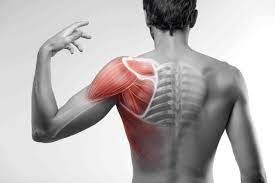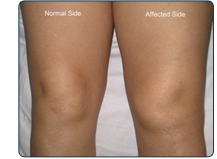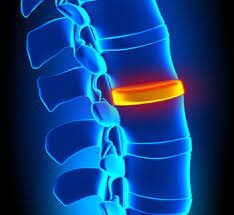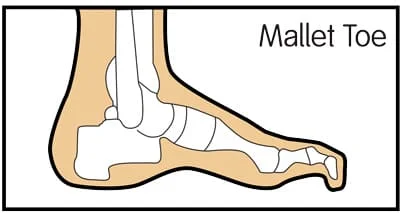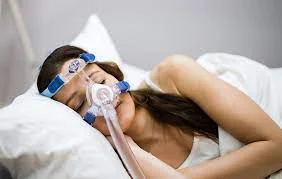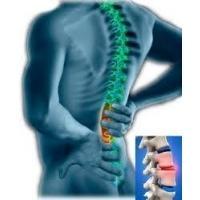Subscapularis pain
Table of Contents
What is a Subscapularis pain?
Subscapularis muscle pain occurs when moving the shoulder, especially during overhead shoulder activity. when the arm is raised above the shoulders you feel pain. An overuse of subscapularis muscle pain may make you feel like you are not able to lift your arm.
Related Anatomy:
The subscapularis muscle is a great triangular-shaped muscle that originates from the subscapular fossa. The word “subscapularis” means under (sub) the scapula (wing bone).
It is part of the four rotator cuff muscles, the other 3 are the supraspinatus, infraspinatus, and teres minor muscles. The subscapularis is the longest and strongest muscle of the rotator cuff.
Origin
- Medial 2/3 of the subscapular fossa.
Insertion
- The fibers make a tendon that inserts into the lesser tubercle of the humerus and the front of the shoulder joint capsule.
Nerve Supply
- Upper and lower subscapular nerves (C5-C6), are stimulated by the posterior cord of the brachial plexus.
- Subscapularis is stimulated by both the upper and lower subscapular nerves which arise from the posterior cord of the brachial plexus.
- The upper subscapular nerve supplies the upper part of the subscapularis, while the lower subscapular nerve branches into 2, with 1 branch supplying the lower part of the subscapularis.
Blood Supply
- Subscapular artery.
Action
- The first function is the internal rotation of the humerus. It assists in shoulder adduction and extension in certain positions.
- Arm position has a particular effect on the actions caused by this muscle:
- when the arm is raised, the subscapularis muscle pulls the arm forward and downward;
- when the humerus is in a fixed position, subscapularis’ insertion may perform as an origin and it generates abduction of the inferior border of the scapula.
- As part of the rotator cuff, Subscapularis plays a vital role in the stabilization of the shoulder.
Pathologies
- Subscapularis may harbor up to 3 trigger points, with the 2 most usually happening near the outside edge of the muscle.
- Luckily, the trigger point on the inside edge of the muscle is much minimal common, because it is closely impossible to contact by palpation and release manually.
- Referred pain from trigger points in the subscapularis muscle concentrates in the posterior shoulder region, with overabundance into the shoulder blade region and down the back of the upper arm.
- A unique “band” of referred pain around the wrist can happen as well.
- Typically an individual is aware of this wrist pain but does not think it is related to their shoulder pain.
- It is frequently injured by throwers.
- Pain with Tenderness and pain will be felt when pressing in on the insertion point of the tendon on the inside of the upper arm.
- Subscapularis tendonitis symptoms involve pain when moving the shoulder specifically when the arm is raised above the shoulders.
- An overused subscapularis muscle may make the person experience like individuals are not able to lift an arm. It may be even responsible for the frozen shoulder.
Symptoms of Subscapularis pain
- The most usual symptom of a subscapularis tear is shoulder pain, specifically in the front of the shoulder.
- A person may also hear or feel “clicking” in the shoulder when the person rotates the arm.
Few symptoms of a subscapularis tear are very common to symptoms of other rotator cuff tears. These involve:
- Pain that gets worse at night
- Shoulder or arm weakness
- Pain that gets worse when a person lifts the arm
Other symptoms of a subscapularis tear are unusual to this injury. These involve:
- ATYA
- Bicep weakness
- Having a hard time reaching for something in the back pocket or reaching for the back
- Pain in the space under the collarbone
- The injured arm rotating outwards (palm facing forwards) without the person moving it
Tests For Subscapularis
Medical tests
- Ultrasound
- MRI scan
Physical therapy test
Lift-Off Test
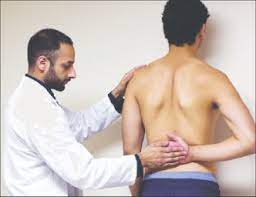
The lift-off test was originally identified by Gerber and Krushell(199l) and is sometimes tends to as ‘Gerber’s Test’.
- The person is examined in standing and is asked to put their hand behind their back with the dorsum of the hand resting in the region of the mid-lumbar spine.
- The dorsum of the hand is raised off the back by maintaining or improving internal rotation of the humerus and extension at the shoulder.
- The ability to actively raise the dorsum of the hand off the back constitutes a normal lift-off test.
- Not being able to move the dorsum of the back indicates an abnormal lift-off test and indicates subscapularis rupture or dysfunction.
Bear Hug Test
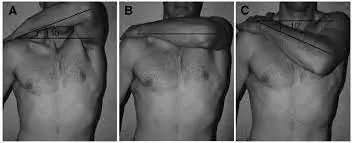
- To do the Bear Hug Test, the person is asked to put the palm of their affected arm on their other shoulder, with their elbow anterior to the body in maximum anterior translation position.
- The patient is instructed to maintain the starting position, while the physician gives an externally rotating force to the person’s forearm.
- The test is positive if the patient may not maintain his arm position or showed internal rotation weakness as compared to the other side, indicating subscapularis muscle tear or dysfunction.
Belly Press Test
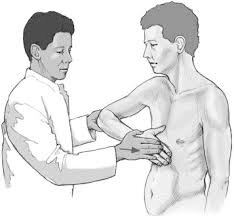
- To do the Belly Press Test the affected arm is placed at the side, with the shoulder flexed ninety degrees and the palm of the hand resting on the person’s belly.
- An individual is instructed to press the palm of his hand against his belly in an internal rotation motion.
- The test is positive if the person showed internal rotation weakness as compared to the other side or pressed on his belly my elbow or shoulder extension instead of internal rotation.
Differential diagnosis
- The differential diagnosis depends on history and clinical findings alone are broad and involve a septic shoulder, pyomyositis, calcific tendinitis, muscle strain, intramuscular hematoma, acute osteomyelitis, myonecrosis, and sarcoma.
Treatment of Subscapularis pain
Subscapularis pain and tendinopathy are rehabbed conservatively through rest, activity modification, analgesia, ice, and physical therapy. Doing ice primarily helps decrease pain and inflammation.
- For massaging the subscapularis muscle utilizing the thumb technique, feel it contracting, then release the tension and begin to massage it.
- Be sure the person only massages the muscle and not the nerves.
- Otherwise, the person is likely to end up with some pain for quite a few days because the person stressed the nerves in the armpit instead of the muscle.
- The treatment of subscapularis tendinitis may differ based on how severe the inflammation can be.
- A subscapular tendon that is mildly or moderately inflamed may be treated with anti-inflammatory medication and applying hot or cold therapy.
- A patient will be suggested to rest for at least 1 to 2 weeks at the time of treatment to help prevent more aggravation of the condition.
- A person should be careful as the subscapularis tendon is a very necessary part of the shoulder joint and rotator cuff.
- A tear that is accompanied by tendon inflammation has to be treated surgically, which includes exposing the tendon to identify the torn ligament.
- Subsequently, the doctor will isolate and dispatch the torn tendon of the rotator cuff and reattach the adjacent normal tendon to its normal position.
Exercises to Help Shoulders with a Subscapularis muscle pain
After subscapularis muscle pain, there will be 5 phases that slowly help the person regain the full range of movement and strength in the shoulder. The 5 phases include:
- The maximum protection phase with passive movement only.
- The muscular endurance phase with introductory active movement.
- The muscular strength phase with resistance exercises.
- Increased muscular strength and a reintroduction to daily activity.
- A return to normal sports activity.
One person has made it to phase 3, a person may perform these exercises at home daily:
Pendulum

This exercise will ease a person into shoulder rotation.
- Step 1: Put one hand on a counter or tabletop for support, lean forward, and let the other hand hang freely.
- Step 2: Slowly swing the arm forward and back, and side to side. Repeat with the other arm.
- Repeat these steps 10 times, twice a day.
Passive Internal Rotation
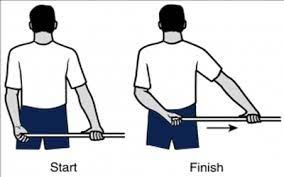
- This exercise is great for stretching the subscapularis and increasing the range of movement.
- Step 1: Grab a light pole, yardstick, or stick behind the back. Slowly grasp the other end of the stick with the other hand.
- Step 2: Pull the stick horizontally so it is passively pulling the shoulder. A person should experience a pull but not pain. Hold for thirty seconds.
- Release and repeat on the opposite side. Perform this for 4 repetitions for both sides.
Internal Rotation
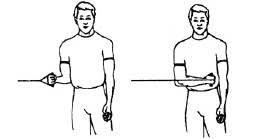
- This exercise is an active exercise utilizing a resistance band. This exercise will make shoulder muscles stronger.
- Step 1: Tie a resistance band to a doorknob or table leg at hip length.
- Step 2: Grab the band with the elbow bent at the side. Keep up the elbow close and bring the arm across the body.
- Step 3: Gently return the arm to the starting position and repeat.
- Repeat this on the opposite side. perform this for 3 sets with eight repetitions on both sides.
Prone Horizontal Abduction
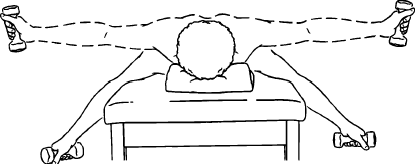
- This exercise will mainly focus on subscapular control. It is felt to stretch and strengthen the subscapularis tendon.
- Step 1: To do this exercise, start by lying face down on a bench or bed with one arm hanging off the side.
- Step 2: Bring the relaxed arm and gently raise it straight out until it is horizontal with the body. Hold for ten seconds.
- Step 3: Gently release to a relaxed position.
- Repeat on the opposite side. Do this for 3 sets with 8 repetitions on both sides.
Safety Considerations
- These exercises are meant to reduce shoulder pain and increase the range of motion.
- Be sure to maintain proper kind when executing this exercise.
- Improper form can cause injury or pain.
- If a person is unsure of formation, watch yourself do the exercise in a mirror, or work with a physical therapist or doctor.
- If a person experience pain at the time of these exercises, decrease the weight and movement of the arms to an acceptable pain-free level.
- If the pain persists, the person can want to contact the doctor or physical therapist to discuss further actions to relieve the subscapularis tear pain.
FAQ
The more usual symptom of a subscapularis tear is shoulder pain, specifically in the front of the shoulder. A person might also hear or feel “clicking” in the shoulder when the person rotates the arm. Some symptoms of a subscapularis tear are very common to symptoms of other rotator cuff tears.
Subscapularis Tendinitis generally happens because of direct trauma to the arm like that in a fall on the shoulders or arm or as an outcome of a sporting injury. A rupture of the tendon can also happen after a surgical procedure like a shoulder replacement surgery in which the subscapularis tendon is removed and repaired.
Laying on the back won’t put pressure on the injured shoulder or force it into an awkward position. For the initial few days or weeks, when symptoms are at their worst, consider sleeping on a wedge pillow or in a recliner. Sleeping on a slight incline will help a person avoid rolling onto the side or stomach in sleep.
When the subscapularis becomes tight, weak, and/or dysfunctional, it may cause an array of problems: Loss of shoulder motion. Pain at the shoulder (diffuse and sharp) with movement. Weakness/loss of shoulder stability.
The subscapularis muscle’s primary function is internal rotation but may also aid in adducting the humerus. The subscapularis nerve innervates the muscle. The subscapular artery gives blood supply, and lymph drainage flows into the axillary nodes.

